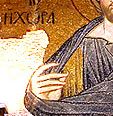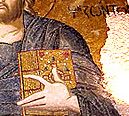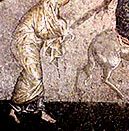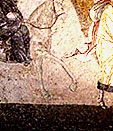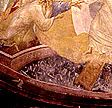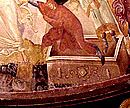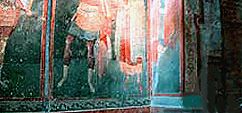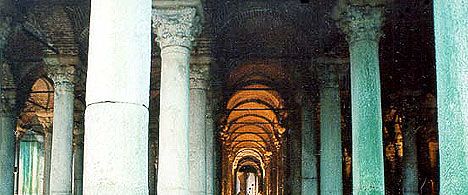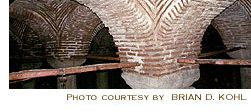Where to Visit Istanbul
If you plan to stay five days in Istanbul and want to spend it as efficient as possible, here are my suggestions for you. You can change the ranking of days upon your request.
After a relaxing day, now you can go back on the track and spare a day for the Topkapi palace and surrounding structures. Take a tram and get off at Sultanahmet station, when you walk to the Square, you will see St Sophia on you left and Blue mosque on your right. Turn left to the backside of St Sophia. This road will lead you to the Palace.
Before reaching the palace two important sights are the Fountain of Sultan Ahmed III and the "Sogukcesme Sokagi". You can easily catch the fountain with its attractive motives and nice Dom. "Sogukçesme Sokagi" with the old Istanbul houses, lays on the other side of the Fountain. Make a short walk in the street and watch for the renovated old Istanbul houses on the Edge of Istanbul Walls. Now you can lead to the big door where is the opening to the first courtyard. In the first court yard on the left side is the St Irene Church. To visit this church is under the admission of St Sophia museum, however I could only find a chance to visit once.
When you enter the Church there is a stone ramp, which descend s a long to the level of the interior. When you reach the interior you will see the semicircular front with semi-domed above and there are seats for the clergy. In the semi-dome, there is an ancient mosaic of a simple cross in a black border.
After your tour in the St Irene Museum, now lead to the entrance of the Topkapi palace. You will see a crowd waiting in front of the ticket offices. And you will easily catch the gate of Topkapi palace. Topkapi palace is open from 9:00 to 16:00 except Tuesdays. Entrance tickets are obtained from the gateway. There are different parts in the museum and each of them has a different entrance fee. The entrance to the Topkapi museum is 10 YTL, (~ 7,5 USD ) Entrance to the Harem is 10 YTL . Harem is inside the palace and has a separate entrance. In order to visit the Harem you need to wait for the tours, there are tours in every half an hour and Harem is closing at 15:30 hrs. (Closing hours represent last entrance time). I would suggest touring the palace first and visiting Harem later. Topkapi palace is probably one of the best palaces you can see on earth. You will definitely be impressed, one missing thing in the palace for me is as everything is on an exhibition you don't see a real reflection of how people were living in the past. Topkapi Palace could take your whole day, but you should spare some time for some other places. After Topkapi palace you can visit the Archeological museum . When you reach the first courtyard outside the palace, you will see the signs showing the Museum. Archeological museum is on the right side below the road. The entrance fee is 5 YTL (3 USD) Open all day except Monday, from 9:00 to 17.00.
When you are finished with the Archeological museum, just walk down the road and you will reach the entrance of Gulhane Park. If you want to relax a bit, a walk in the park will be very nice. Park has been re-organized recently and has a very nice looking with so many nice and colorful flowers. The day is not over yet. One more activity can fit for this day and this is a visit to Miniaturk. Miniaturk is a mini model park of Turkiye.
The park is open from 09:00 to 17:00. And in summer it is open till 20:00 hrs. So a late visit is still possible in summer days. On miniaturk Turkey's rich historical and cultural heritage is being displayed with their Marquet te's. If you plan a visit to Istanbul, this is a must see event, you should put in to your agenda. You can have snap to all main structures in Turkey in such a short time. After the Park or skipping the park after the museum, you shall w alk or take the tram to eminonu, to reach to Miniaturk I advice taking a taxi from Eminonu. It shall cost 9 -10 YTL (~ 6-7 USD) The entrance fee to the park is around 10 YTL (~ 7 USD). .
The park is located over on a 56-hectare area along the coast of the Golden Horn. Hagia Sophia, Aspendos Theater, Suleymaniye Mosque, Sumela Monastery, Fairy Chimneys, Mount Nemrud and the ancient city of Ephesus are some of those among the historical and cultural works of art in the park. There is also a small bridge, which is copied from the Bosphorus Bridge between Europe and Asia.
After Miniaturk you can again take a taxi to Eminonu and back to your hotel. Or since you are in Golden horn, a visit to "Cibalikapi" fish restaurant will be favorable.
Another Day in Istanbul. Dolmabahce Palace , Taksim Square, Istiklal Street and Galata tower are the sights of the day's program. Now we are going to take a bus from Eminonu to go to Dolmabahce Palace. In front of the ferry port, buses leaves to various parts of Istanbul. If you get on the Bus from Eminonu to Besiktas, you will pass in front of the Palace. You need to get a ticket for the bus and it costs 1,3 YTL, (1 USD). After 3-4 stops you will see a place where Sea buses and Ferries port (Kabatas), you need to get off from here if you happen to pass this stop do not mind you can get off the next stop and walk back.. When you stopped at Kabatas walk to the front and after 200 meters you will see the Dolmabahce palace on the Right side at the seaside. Dolmabahce palace is closed on Monday and Thursdays and open for public from 9:00 to 16:00. There are two parts on the palace "Selamlik" and "Harem", and both have different entrance fees. Fees are for Selamlik 12 YTL (~9 USD) and for Harem is 10 YTL. You can have a ticket for both of them for 18 YTL. On the entrance there are tour guides arranged by the palace and they are gathering people and you are touring the palace with small groups. You need to wear blue plastic covers to your shoes. Palace itself could remind you of the Versailles palace in Paris, however for me it is more elegant. During your visit you will stop inside the room of Ataturk, founder of the Turkish republic. He has passed away in this palace and his room is still kept in the same order. Note: Video Cameras and Photos are subject to an extra fee.
After your tour at Dolmabahce palace, you can visit the Taksim Square. you need the climb up the hill and reach the Taksim Square, a tough walking or you better take a taxi, should cost 3-4 USD max... Taksim square is the biggest square in Istanbul, many events are being celebrated on this square and it is always crowded. You can see the Ataturk statue at the end of the square and also you can see the nostalgic tram of old Istanbul. Tram operates at the Istiklal Street, which is one of the main pedestrian streets in Istanbul. The street, houses many restaurants, consulates, shops and fair grounds. It is a good alternative for shopping. And the atmosphere is very nice. I advice you to walk on this street till the end of it. You will enjoy this street and it may become one of your favorite places in Istanbul. This street is also nice at nights but could be dangerous after very late hours (2 am or so). At the end of the Istiklal street you will see an old metro which is coming from the 19 the Century. However you can keep on walking to the Galata tower. Where you can have a wonderful view of Istanbul. Galata tower was built in 1348 as a watchtower for fires. And today it's a favorable touristy place. After your tour at Galata tower, you can walk down the road and reach Karakoy, other side of Eminonu. Just pass the bridge and you are back to Eminonu.
Ortaköy is the place to visit on your last day. Ortakoy District is very favorable on sundays. If you are lucky and the sun is also shining, then you will definitely have memorable moments at Ortaköy. Ortaköy is one of the must see places at Istanbul and if you happen to be there on a Sunday, than you will enjoy more. A small part of the city, on the Bosphorus shore, hosts a Sunday market and weekend attractions for Locals. However it's attractive for Tourists also. You can find very interesting handmade stuffs as well as paints and silver accessories. The historical houses and streets are under protection and most have been restored. You can see people gathered around the Ibrahim Pasha fountain every day. Watching the sail boats docked at the wharf is an interesting sight also.. There are many coffee and teahouses, restaurants, fast-food shops in Ortaköy. Eating authentic Turkish food such as gözleme or eating Baked potato is a favorite thing.
Walking distance from Besiktas (A tough one). There are buses and regular taxis passing from the Region. Just at the edge of the Bosphorus Bridge (1st one). The buses that leaves to Ortakoy from Eminonu are 22, 22 RE And 25.
After Ortakoy, you can have a snap to Bebek also . Once, the Bay was for the fishing boats to secure themselves, now hosts the Ultra yachts and speed boats. Probably one of most elegant district of Istanbul with so nice houses and best view of Bosphorus. Bebek is also one of the richest districts of Istanbul. In the center of Bebek stood the Bebek mosque. Also the entrance of the Bosphorus University is nearby. If you have the courage to climb all the way up. The view from the top is enormous. Bebek is so nice to walk around. Walk on the coast and walk in the Bebek Park. Sit on a Bank and enjoy the beauty and silence. If you like desert, try he "Bebek Badem Ezmecisi", a delicious Turkish desert. Also there are very nice Cafes at Bebek. How to reach Bebek: There are regular buses from Eminonu, Besiktas & Taksim
Devamını Oku
If you plan to stay five days in Istanbul and want to spend it as efficient as possible, here are my suggestions for you. You can change the ranking of days upon your request.
After a relaxing day, now you can go back on the track and spare a day for the Topkapi palace and surrounding structures. Take a tram and get off at Sultanahmet station, when you walk to the Square, you will see St Sophia on you left and Blue mosque on your right. Turn left to the backside of St Sophia. This road will lead you to the Palace.
Before reaching the palace two important sights are the Fountain of Sultan Ahmed III and the "Sogukcesme Sokagi". You can easily catch the fountain with its attractive motives and nice Dom. "Sogukçesme Sokagi" with the old Istanbul houses, lays on the other side of the Fountain. Make a short walk in the street and watch for the renovated old Istanbul houses on the Edge of Istanbul Walls. Now you can lead to the big door where is the opening to the first courtyard. In the first court yard on the left side is the St Irene Church. To visit this church is under the admission of St Sophia museum, however I could only find a chance to visit once.
When you enter the Church there is a stone ramp, which descend s a long to the level of the interior. When you reach the interior you will see the semicircular front with semi-domed above and there are seats for the clergy. In the semi-dome, there is an ancient mosaic of a simple cross in a black border.
After your tour in the St Irene Museum, now lead to the entrance of the Topkapi palace. You will see a crowd waiting in front of the ticket offices. And you will easily catch the gate of Topkapi palace. Topkapi palace is open from 9:00 to 16:00 except Tuesdays. Entrance tickets are obtained from the gateway. There are different parts in the museum and each of them has a different entrance fee. The entrance to the Topkapi museum is 10 YTL, (~ 7,5 USD ) Entrance to the Harem is 10 YTL . Harem is inside the palace and has a separate entrance. In order to visit the Harem you need to wait for the tours, there are tours in every half an hour and Harem is closing at 15:30 hrs. (Closing hours represent last entrance time). I would suggest touring the palace first and visiting Harem later. Topkapi palace is probably one of the best palaces you can see on earth. You will definitely be impressed, one missing thing in the palace for me is as everything is on an exhibition you don't see a real reflection of how people were living in the past. Topkapi Palace could take your whole day, but you should spare some time for some other places. After Topkapi palace you can visit the Archeological museum . When you reach the first courtyard outside the palace, you will see the signs showing the Museum. Archeological museum is on the right side below the road. The entrance fee is 5 YTL (3 USD) Open all day except Monday, from 9:00 to 17.00.
When you are finished with the Archeological museum, just walk down the road and you will reach the entrance of Gulhane Park. If you want to relax a bit, a walk in the park will be very nice. Park has been re-organized recently and has a very nice looking with so many nice and colorful flowers. The day is not over yet. One more activity can fit for this day and this is a visit to Miniaturk. Miniaturk is a mini model park of Turkiye.
The park is open from 09:00 to 17:00. And in summer it is open till 20:00 hrs. So a late visit is still possible in summer days. On miniaturk Turkey's rich historical and cultural heritage is being displayed with their Marquet te's. If you plan a visit to Istanbul, this is a must see event, you should put in to your agenda. You can have snap to all main structures in Turkey in such a short time. After the Park or skipping the park after the museum, you shall w alk or take the tram to eminonu, to reach to Miniaturk I advice taking a taxi from Eminonu. It shall cost 9 -10 YTL (~ 6-7 USD) The entrance fee to the park is around 10 YTL (~ 7 USD). .
The park is located over on a 56-hectare area along the coast of the Golden Horn. Hagia Sophia, Aspendos Theater, Suleymaniye Mosque, Sumela Monastery, Fairy Chimneys, Mount Nemrud and the ancient city of Ephesus are some of those among the historical and cultural works of art in the park. There is also a small bridge, which is copied from the Bosphorus Bridge between Europe and Asia.
After Miniaturk you can again take a taxi to Eminonu and back to your hotel. Or since you are in Golden horn, a visit to "Cibalikapi" fish restaurant will be favorable.
Another Day in Istanbul. Dolmabahce Palace , Taksim Square, Istiklal Street and Galata tower are the sights of the day's program. Now we are going to take a bus from Eminonu to go to Dolmabahce Palace. In front of the ferry port, buses leaves to various parts of Istanbul. If you get on the Bus from Eminonu to Besiktas, you will pass in front of the Palace. You need to get a ticket for the bus and it costs 1,3 YTL, (1 USD). After 3-4 stops you will see a place where Sea buses and Ferries port (Kabatas), you need to get off from here if you happen to pass this stop do not mind you can get off the next stop and walk back.. When you stopped at Kabatas walk to the front and after 200 meters you will see the Dolmabahce palace on the Right side at the seaside. Dolmabahce palace is closed on Monday and Thursdays and open for public from 9:00 to 16:00. There are two parts on the palace "Selamlik" and "Harem", and both have different entrance fees. Fees are for Selamlik 12 YTL (~9 USD) and for Harem is 10 YTL. You can have a ticket for both of them for 18 YTL. On the entrance there are tour guides arranged by the palace and they are gathering people and you are touring the palace with small groups. You need to wear blue plastic covers to your shoes. Palace itself could remind you of the Versailles palace in Paris, however for me it is more elegant. During your visit you will stop inside the room of Ataturk, founder of the Turkish republic. He has passed away in this palace and his room is still kept in the same order. Note: Video Cameras and Photos are subject to an extra fee.
After your tour at Dolmabahce palace, you can visit the Taksim Square. you need the climb up the hill and reach the Taksim Square, a tough walking or you better take a taxi, should cost 3-4 USD max... Taksim square is the biggest square in Istanbul, many events are being celebrated on this square and it is always crowded. You can see the Ataturk statue at the end of the square and also you can see the nostalgic tram of old Istanbul. Tram operates at the Istiklal Street, which is one of the main pedestrian streets in Istanbul. The street, houses many restaurants, consulates, shops and fair grounds. It is a good alternative for shopping. And the atmosphere is very nice. I advice you to walk on this street till the end of it. You will enjoy this street and it may become one of your favorite places in Istanbul. This street is also nice at nights but could be dangerous after very late hours (2 am or so). At the end of the Istiklal street you will see an old metro which is coming from the 19 the Century. However you can keep on walking to the Galata tower. Where you can have a wonderful view of Istanbul. Galata tower was built in 1348 as a watchtower for fires. And today it's a favorable touristy place. After your tour at Galata tower, you can walk down the road and reach Karakoy, other side of Eminonu. Just pass the bridge and you are back to Eminonu.
Ortaköy is the place to visit on your last day. Ortakoy District is very favorable on sundays. If you are lucky and the sun is also shining, then you will definitely have memorable moments at Ortaköy. Ortaköy is one of the must see places at Istanbul and if you happen to be there on a Sunday, than you will enjoy more. A small part of the city, on the Bosphorus shore, hosts a Sunday market and weekend attractions for Locals. However it's attractive for Tourists also. You can find very interesting handmade stuffs as well as paints and silver accessories. The historical houses and streets are under protection and most have been restored. You can see people gathered around the Ibrahim Pasha fountain every day. Watching the sail boats docked at the wharf is an interesting sight also.. There are many coffee and teahouses, restaurants, fast-food shops in Ortaköy. Eating authentic Turkish food such as gözleme or eating Baked potato is a favorite thing.
Walking distance from Besiktas (A tough one). There are buses and regular taxis passing from the Region. Just at the edge of the Bosphorus Bridge (1st one). The buses that leaves to Ortakoy from Eminonu are 22, 22 RE And 25.
After Ortakoy, you can have a snap to Bebek also . Once, the Bay was for the fishing boats to secure themselves, now hosts the Ultra yachts and speed boats. Probably one of most elegant district of Istanbul with so nice houses and best view of Bosphorus. Bebek is also one of the richest districts of Istanbul. In the center of Bebek stood the Bebek mosque. Also the entrance of the Bosphorus University is nearby. If you have the courage to climb all the way up. The view from the top is enormous. Bebek is so nice to walk around. Walk on the coast and walk in the Bebek Park. Sit on a Bank and enjoy the beauty and silence. If you like desert, try he "Bebek Badem Ezmecisi", a delicious Turkish desert. Also there are very nice Cafes at Bebek. How to reach Bebek: There are regular buses from Eminonu, Besiktas & Taksim


